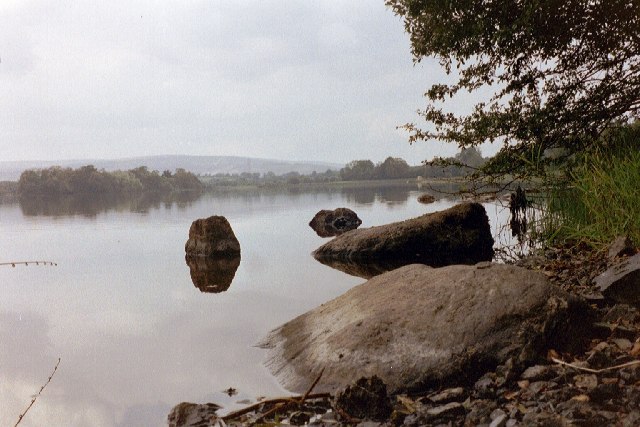|
Corranierna
Corranierna is a townland in the Parish of Tomregan, Barony of Tullyhaw, County Cavan, Ireland. (Disambiguation see also- Corranierna (Corlough) townland, County Cavan, Republic of Ireland.) Etymology The townland name is an anglicisation of either (1) ''Cor an Iarna'', meaning 'The Hill of the Skein (of thread)’, which derived its name from the weavers who lived there. In the 1938 Dúchas Folklore Collection there is an account of a flax mill in Corranierna, or (2) The local pronunciation however is 'Corr-Nern-Yah', which seems to indicate a different meaning: ''Cor na nAirchinneach'', meaning 'The Hill of the Erenagh'. On the 1609 Ulster Plantation Baronial map it forms part of Mullaghduff townland. On the Down Survey map of 1655 it was still part of Mullaghduff. A 1666 grant includes it as ''Mullaghduffe alias Cloghane alias Cormerin''. A deed dated 2 May 1724 includes the townland as ''Mullaghduffe alias Cloghane alias Cormerin''. Corranierna remained as part of Mullagh ... [...More Info...] [...Related Items...] OR: [Wikipedia] [Google] [Baidu] |
Corranierna (Corlough)
Corranierna (Corlough) () is a townland in the civil parish of Templeport, County Cavan, Ireland. It lies in the Roman Catholic parish of Corlough and barony of Tullyhaw. Geography Corranierna is bounded on the west by Corraclassy and Gubnagree townlands, on the south by Derrynaslieve townland and on the east by Garvary (Corlough) and Derry Beg townlands. Its chief geographical features are the Owensallagh river (A source of the River Blackwater, County Cavan), forestry plantations and dug wells. Corranierna is traversed by minor public roads and rural lanes. The townland covers 60 statute acres. History In earlier times the townland was probably uninhabited as it consists mainly of bog and poor clay soils. It was not seized by the English during the Plantation of Ulster in 1610 or in the Cromwellian Settlement of the 1660s so some dispossessed Irish families moved there and began to clear and farm the land. The Tithe Applotment Books for 1826 list ten tithepayers in the townl ... [...More Info...] [...Related Items...] OR: [Wikipedia] [Google] [Baidu] |
Mullaghduff, County Cavan
Mullaghduff (Irish: ''Mullach Dubh'') is a townland in the Parish of Tomregan, Barony of Tullyhaw, County Cavan, Ireland. Etymology The townland name is an anglicisation of the Gaelic placename 'Mullach Dubh' which means "The Black Hilltop", which probably derives from the blackish soil which covers the hill. The 1609 Ulster Plantation Baronial map spells the name as ''Mulladuff''. A 1610 grant spells the name as ''Mullaghduffe''. A 1630 Inquisition spells it as ''Mullaghduffe''. The 1641 Rebellion Depositions as ''Mullaighduffe'', the 1652 Commonwealth Survey as ''Mullaghduffe'' and the 1659 Down Survey map spells it as ''Mullaghduffe''. A 1666 grant spells it as Mullaghduffe. William Petty's 1685 map spells it as ''Mulladuf''. Geography It is bounded on the north by Annagh and Corranierna townlands, on the west by Cullyleenan and Agharaskilly townlands, on the south by Cavanagh (townland) and on the east by Cranaghan and Killywilly townlands. Its chief geographical featur ... [...More Info...] [...Related Items...] OR: [Wikipedia] [Google] [Baidu] |
Annagh, County Cavan
Annagh is a townland in the Parish of Tomregan, Barony of Tullyhaw, County Cavan, Ireland. Etymology On the 1609 Ulster Plantation Baronial map it is split into two townlands named ''Shannaontra'' and ''Shannaititr''. In a 1610 grant they are spelled ''Tanaghyeightra'' and ''Tanaghwotra''. In an Inquisition dated 20 September 1630 the two townlands were spelled ''Townaeiateragh'' and ''Tawnaowteragh''. In the 1652 Commonwealth Survey the spelling was ''Tenaghoghtragh'' and ''Tenaghightragh''. On the Down Survey map of 1655 these townlands were merged into one and it is named ''Annagh''. A 1666 grant spells the names as ''Anagh alias Tannaghyeitragh alias Tannaghowoteragh''. William Petty's 1685 map spells it as ''An''. The usual meaning suggested for the place name is that Annagh is an anglicisation of the Irish language placename "Eanach" which means 'A moor or marsh'. However it is more likely that Annagh is an abbreviation of 'Tannagh' (meaning a pasture) as the older names o ... [...More Info...] [...Related Items...] OR: [Wikipedia] [Google] [Baidu] |
Killywilly
Killywilly is a townland in the civil parish of Drumlane, Barony of Loughtee Lower, County Cavan, Ireland. Etymology The townland name is an anglicisation of a Gaelic placename, either ''Coill Mhuilinn'', meaning 'The Wood of the Mill', or ''Coillidh Bhuaile'', meaning 'The Wood of the Cattle-Fold', or ''Coill an Bhealaigh'', meaning ‘The Wood of the Pass’. The first name is more likely as there was a mill there at least as early as the 17th century and most of the early placename spellings are consistent with this. The earliest surviving mention of the townland is on the 1609 Ulster Plantation map of the Barony of Loughtee, where it is spelled ''Killivelly''. A 1610 grant spells it as ''Keilenolin''. The 1654 Commonwealth Survey spells it as ''Killevullin''. The 1660 Books of Survey and Distribution spell it as ''Killycullen''. The 1661 Inquisitions spell it as ''Kelewolin'' and ''Killewooley''. The 1790 Cavan Carvaghs list spells the name as ''Killevally''. Geography K ... [...More Info...] [...Related Items...] OR: [Wikipedia] [Google] [Baidu] |
Tomregan
Tomregan ( ga, Tuaim Dreagain, ) is a civil parish in the ancient barony of Tullyhaw. The parish straddles the international border between the Republic of Ireland and Northern Ireland. The largest population centre in the parish is Ballyconnell, County Cavan. The total area of the civil parish is 10,600 statute acres. Most of Tomregan's constituent townlands are situated in County Cavan while the remainder lie in County Fermanagh. In the Catholic Church, the ecclesiastical parish of Tomregan was split in the early 18th century, with the County Fermanagh townlands being assigned to the parish of Knockninny while the County Cavan townlands were united with the parish of Kildallan. The townlands The Fermanagh townlands in Tomregan civil parish are- Aghindisert, Carickaleese, Cloncoohy, Derrintony, Derryart, Garvary, Gortahurk, Gortaree, Gortineddan, Gortmullan, Knockadoois, Knockateggal, Tonymore and Ummera. The Cavan townlands in Tomregan civil parish are- Agharas ... [...More Info...] [...Related Items...] OR: [Wikipedia] [Google] [Baidu] |
Census Of Ireland, 1901
A census is the procedure of systematically acquiring, recording and calculating information about the members of a given population. This term is used mostly in connection with national population and housing censuses; other common censuses include censuses of agriculture, traditional culture, business, supplies, and traffic censuses. The United Nations (UN) defines the essential features of population and housing censuses as "individual enumeration, universality within a defined territory, simultaneity and defined periodicity", and recommends that population censuses be taken at least every ten years. UN recommendations also cover census topics to be collected, official definitions, classifications and other useful information to co-ordinate international practices. The UN's Food and Agriculture Organization (FAO), in turn, defines the census of agriculture as "a statistical operation for collecting, processing and disseminating data on the structure of agriculture, covering th ... [...More Info...] [...Related Items...] OR: [Wikipedia] [Google] [Baidu] |
Griffith's Valuation
Griffith's Valuation was a boundary and land valuation survey of Ireland completed in 1868. Griffith's background Richard John Griffith started to value land in Scotland, where he spent two years in 1806-1807 valuing terrain through the examination of its soils. He used 'the Scotch system of valuation' and it was a modified version of this that he introduced into Ireland when he assumed the position of Commissioner of Valuation. Tasks in Ireland In 1825 Griffith was appointed by the British Government to carry out a boundary survey of Ireland. He was to mark the boundaries of every county, barony, civil parish and townland in preparation for the first Ordnance Survey. He completed the boundary work in 1844. He was also called upon to assist in the preparation of a Parliamentary bill to provide for the general valuation of Ireland. This Act was passed in 1826, and he was appointed Commissioner of Valuation in 1827, but did not start work until 1830 when the new 6" maps, became ... [...More Info...] [...Related Items...] OR: [Wikipedia] [Google] [Baidu] |
Sunday School
A Sunday school is an educational institution, usually (but not always) Christian in character. Other religions including Buddhism, Islam, and Judaism have also organised Sunday schools in their temples and mosques, particularly in the West. Sunday school classes usually precede a Sunday church service and are used to provide catechesis to Christians, especially children and teenagers, and sometimes adults as well. Churches of many Christian denominations have classrooms attached to the church used for this purpose. Many Sunday school classes operate on a set curriculum, with some teaching attendees a catechism. Members often receive certificates and awards for participation, as well as attendance. Sunday school classes may provide a light breakfast. On days when Holy Communion is being celebrated, however, some Christian denominations encourage fasting before receiving the Eucharistic elements. Early history Sunday schools were first set up in the 18th century in England ... [...More Info...] [...Related Items...] OR: [Wikipedia] [Google] [Baidu] |
Bawnboy
Bawnboy () is a small village and townland in a valley at the foot of Slieve Rushen, between Ballyconnell and Swanlinbar, in County Cavan, Ireland. A synod of the Roman Catholic Provincial Council of Armagh was held in Owengallees, Baunbuidhe (Bawnboy) on 25 May 1669 where the Bishop of Kilmore, Eugene MacSweeney tried to depose Thomas Fitzsimons, the vicar general of the diocese. Bawnboy is part of the ancient parish of Templeport, birthplace of St Mogue. Its most famous building is a Victorian workhouse, built in 1853, long disused and now derelict. Early history In medieval times the McGovern barony of Tullyhaw was divided into economic taxation areas called ballibetoes, from the Irish ''Baile Biataigh'' (Anglicized as "Ballybetagh"), meaning 'A Provisioner's Town or Settlement'. The original purpose was to enable the farmer, who controlled the baile, to provide hospitality for those who needed it, such as poor people and travellers. The ballybetagh was further divided int ... [...More Info...] [...Related Items...] OR: [Wikipedia] [Google] [Baidu] |
Cavan And Leitrim Railway
The Cavan & Leitrim Railway was a narrow gauge railway in the counties of Leitrim and Cavan in northwest Ireland, which ran from 1887 until 1959. Unusually for Ireland, this narrow gauge line survived on coal traffic, from the mine at Arigna, although the original main line was constructed principally for traffic in cattle. It outlived most of the other Irish narrow-gauge lines, giving a further lease of life to some of their redundant engines. Early years Perhaps it was the brainchild of the Earl of Kingston of Kilronan Castle, Ballyfarnon, to bring prosperity to this part of Ireland. In September 1883, a public meeting in Ballinamore declared that a light railway and tramway would open up the coal and iron districts of Arigna and Lough Allen. The Cavan, Leitrim & Roscommon Light Railway & Tramway Company was set up with a guaranteed capital of £202,000 in 40,400 shares of £5 each. Chairman of the board was the Rt.Hon. The Earl of Kingston D.L., Kilronan Castle. La ... [...More Info...] [...Related Items...] OR: [Wikipedia] [Google] [Baidu] |








